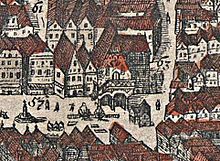Schranne (Vienna)

The Schranne was the seat of the City and Regional Court of Vienna for centuries .
history
Since the end of the 12th century, the function of a city judge has been occupied in Vienna , who was responsible for civil proceedings in the area of the castle keep and punished smaller criminal cases with fines. In addition to the area within the city walls, the keep extended to some areas of the suburbs. At the same time, the judge also exercised the high level of jurisdiction of a regional court, whose jurisdiction extended beyond the castle keep. The Schranne as the seat of the Vienna City and Regional Court can be traced back to 1325.
Until the beginning of the 14th century it was probably located at today's address 8 Tuchlauben . Then it was in front of today's address Hoher Markt 10–11. After a fire in 1437, the courthouse was rebuilt in 1438–41 as a stately late Gothic building at today's address, Hoher Markt 5. The pillory stood in front of the courthouse, from whose characteristic balcony, accessible via an outside staircase, the judgments were read . The Schranne also had an in-house chapel, "To Christ's Death . "
In 1630 and 1740 the court house was rebuilt and enlarged by adding a storey, the balcony, which can be reached on one side and later on both sides through external steps, became a classicist loggia.
In 1839 the criminal court was relocated to the regional court building (“Graues Haus”, today Vienna Josefstadt prison ) in Alservorstadt , and the civil court was dissolved in 1848/51. Then the historic building was demolished and in 1855 a residential building was built in its place with a simple facade rounded towards the Tuchlauben.
On the occasion of the International Theater Exhibition of 1892 in the Prater , the medieval Schranne, as it appears in Jacob Hoefnagel 1609, was briefly rebuilt as part of a staging of Old Vienna.
See also
literature
- Felix Czeike : District Culture Guide Inner City . P. 79f, Vienna 1983
- Wilhelm Kisch : The old streets and squares of Vienna and their historically most interesting houses. A contribution to the cultural history of Vienna with regard to patriotic art, architecture, music and literature. Vienna, Gottlieb, 1883 (Volume 1, Inner City)
- Richard Perger: The high market . Vienna Zsolnay 1970
- Richard Perger: The building history of the Vienna Schrannen building and
- Günter Buchinger: The building history of the Wiener Schranne , both in the yearbook for the history of the city of Vienna 2001/2002 (vol. 57/58).
Coordinates: 48 ° 12 ′ 39.4 ″ N , 16 ° 22 ′ 19.6 ″ E
Individual evidence
- ↑ Friedrich Forsthuber: The history of the “gray house” and criminal justice in Vienna. In: Thomas Olechowski (Ed.): Contributions to the legal history of Austria. Volume 2 / 2016. Verlag der Österreichischen Akademie der Wissenschaften, Vienna 2016, ISBN 978-3-7001-8059-3 , pp. 409-410, chapter online at austriaca.at (PDF; 208 kB).